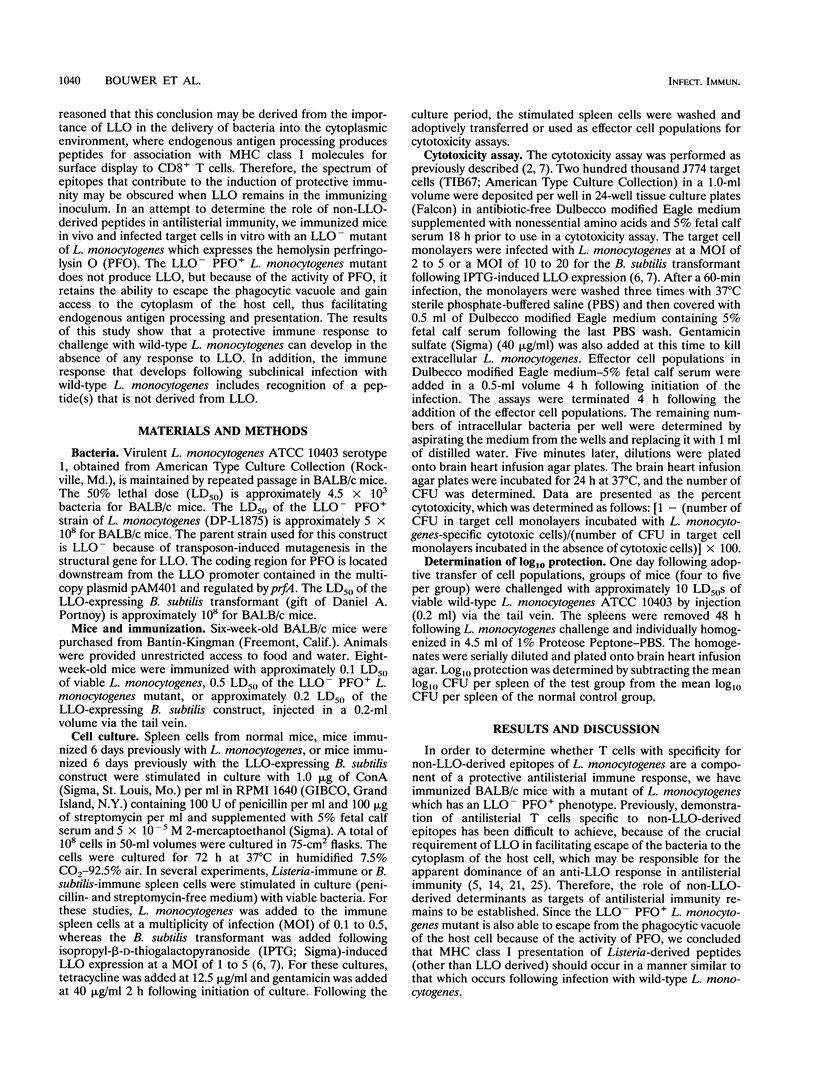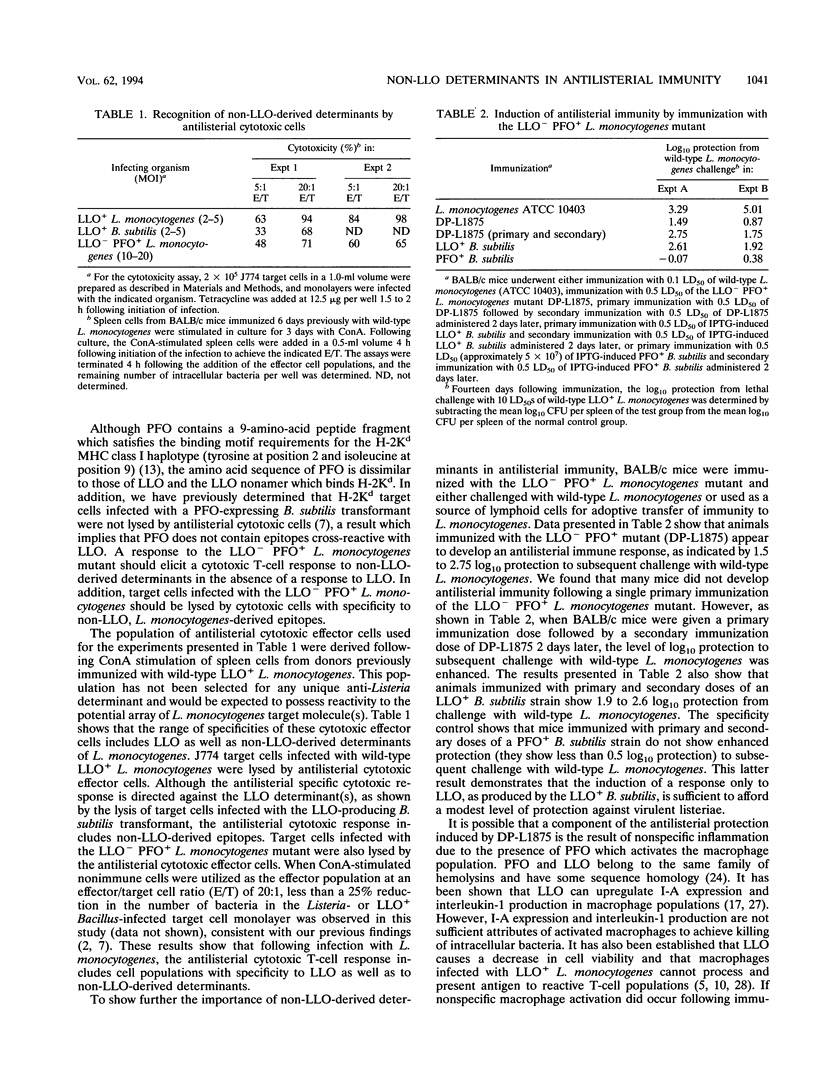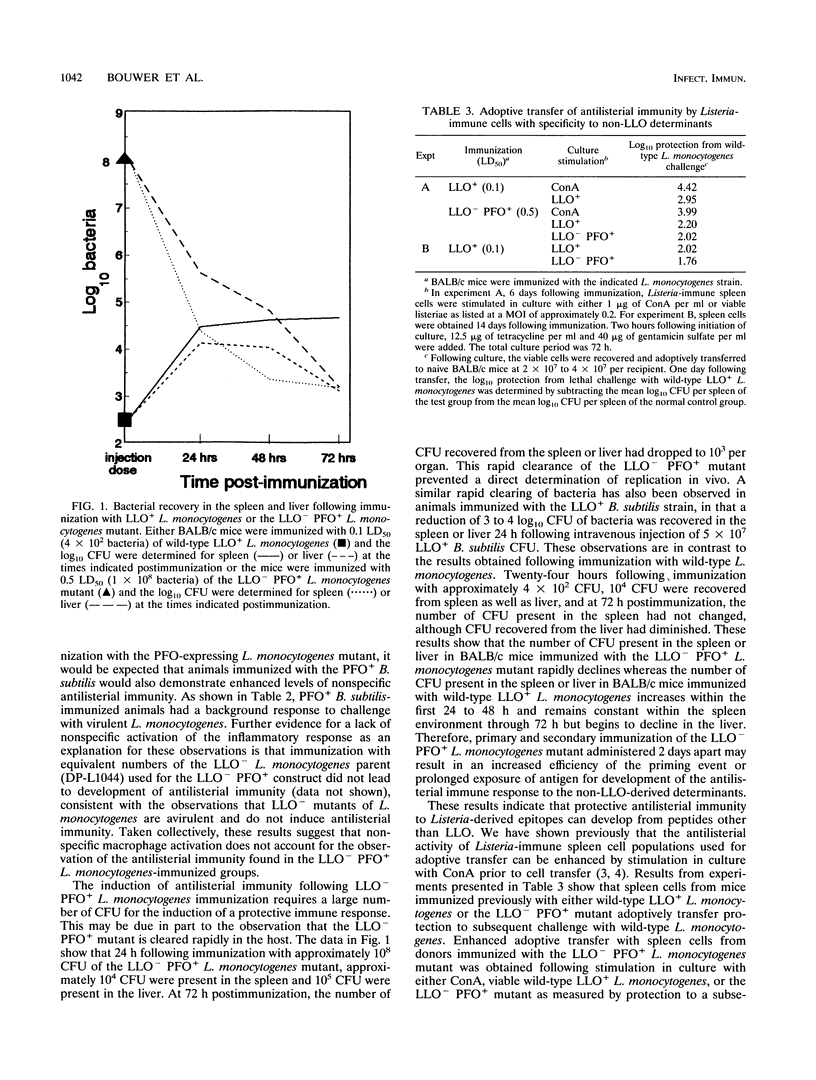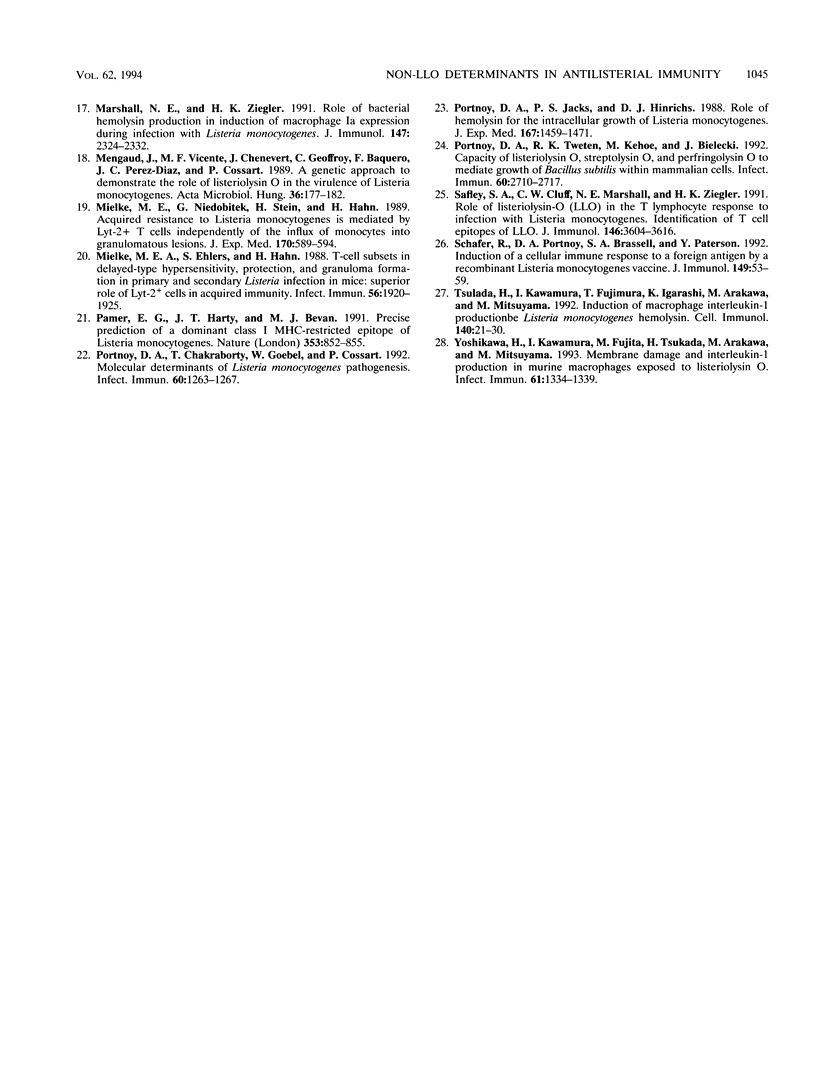Abstract
Subclinical infection of BALB/c mice with virulent Listeria monocytogenes leads to the generation of Listeria-specific T-cell populations required for the expression of protective immunity. The L. monocytogenes-produced hemolysin listeriolysin O (LLO) is a virulence factor which appears to be crucial for the induction of protective antilisterial immunity. Analysis of the specificity of antilisterial cytotoxic cells from Listeria-immune BALB/c donors has shown a dominant response to an epitope corresponding to amino acids 91 to 99 of LLO. Demonstration of antilisterial T cells with specificity to non-LLO-derived epitopes has been difficult to achieve because of the requirement of LLO in facilitating escape of the bacteria to the cytoplasm of the host cell and the apparent dominance of an anti-LLO response in antilisterial immunity. In this study we show that antilisterial immunity also includes specificity to non-LLO-derived determinants. We used as an immunogen an LLO- mutant of L. monocytogenes which expresses the hemolysin perfringolysin O (PFO). The LLO- PFO+ L. monocytogenes mutant possesses invasive properties similar to those of wild-type L. monocytogenes and escape from the phagocytic vacuole because of the activity of PFO. We found that J774 target cells infected with the LLO- PFO+ L. monocytogenes mutant were lysed by antilisterial cytotoxic T cells obtained from BALB/c mice immunized with wild-type L. monocytogenes. In addition, BALB/c mice immunized with the LLO- PFO+ L. monocytogenes mutant were immune to challenge with LLO+ wild-type L. monocytogenes, a finding indicative of protective antilisterial immunity specific to Listeria-derived epitopes other than LLO. Spleen cells from BALB/c mice immunized with the LLO- PFO+ L. monocytogenes mutant adoptively transferred antilisterial protection to a subsequent challenge with wild-type L. monocytogenes. This splenocyte population also contained cytotoxic cells which lysed target cells infected with either the LLO- PFO+ L. monocytogenes mutant or wild-type LLO+ L. monocytogenes but did not lyse target cells infected with an LLO-expressing Bacillus subtilis transformant. These results establish that during the immune response to L. monocytogenes, immune splenocytes with specificity for LLO and other, non-LLO-derived epitopes develop. These non-LLO epitopes serve as targets for antilisterial cytotoxic cells and for lymphocytes which adoptively transfer antilisterial immunity.
Full text
PDF






Selected References
These references are in PubMed. This may not be the complete list of references from this article.
- Baldridge J. R., Barry R. A., Hinrichs D. J. Expression of systemic protection and delayed-type hypersensitivity to Listeria monocytogenes is mediated by different T-cell subsets. Infect Immun. 1990 Mar;58(3):654–658. doi: 10.1128/iai.58.3.654-658.1990. [DOI] [PMC free article] [PubMed] [Google Scholar]
- Barry R. A., Bouwer H. G., Portnoy D. A., Hinrichs D. J. Pathogenicity and immunogenicity of Listeria monocytogenes small-plaque mutants defective for intracellular growth and cell-to-cell spread. Infect Immun. 1992 Apr;60(4):1625–1632. doi: 10.1128/iai.60.4.1625-1632.1992. [DOI] [PMC free article] [PubMed] [Google Scholar]
- Barry R. A., Hinrichs D. J. Enhanced adoptive transfer of immunity to Listeria monocytogenes after in vitro culture of murine spleen cells with concanavalin A. Infect Immun. 1982 Feb;35(2):560–565. doi: 10.1128/iai.35.2.560-565.1982. [DOI] [PMC free article] [PubMed] [Google Scholar]
- Barry R. A., Hinrichs D. J. Lack of correlative enhancement of passive transfer of delayed-type hypersensitivity and antilisterial resistance when using concanavalin A-stimulated primed spleen cells. Infect Immun. 1983 Mar;39(3):1208–1213. doi: 10.1128/iai.39.3.1208-1213.1983. [DOI] [PMC free article] [PubMed] [Google Scholar]
- Beattie I. A., Swaminathan B., Ziegler H. K. Cloning and characterization of T-cell-reactive protein antigens from Listeria monocytogenes. Infect Immun. 1990 Sep;58(9):2792–2803. doi: 10.1128/iai.58.9.2792-2803.1990. [DOI] [PMC free article] [PubMed] [Google Scholar]
- Bielecki J., Youngman P., Connelly P., Portnoy D. A. Bacillus subtilis expressing a haemolysin gene from Listeria monocytogenes can grow in mammalian cells. Nature. 1990 May 10;345(6271):175–176. doi: 10.1038/345175a0. [DOI] [PubMed] [Google Scholar]
- Bouwer H. G., Nelson C. S., Gibbins B. L., Portnoy D. A., Hinrichs D. J. Listeriolysin O is a target of the immune response to Listeria monocytogenes. J Exp Med. 1992 Jun 1;175(6):1467–1471. doi: 10.1084/jem.175.6.1467. [DOI] [PMC free article] [PubMed] [Google Scholar]
- Brown M. L., Fields P. E., Kurlander R. J. Metabolic requirements for macrophage presentation of Listeria monocytogenes to immune CD8 cells. J Immunol. 1992 Jan 15;148(2):555–561. [PubMed] [Google Scholar]
- Brunt L. M., Portnoy D. A., Unanue E. R. Presentation of Listeria monocytogenes to CD8+ T cells requires secretion of hemolysin and intracellular bacterial growth. J Immunol. 1990 Dec 1;145(11):3540–3546. [PubMed] [Google Scholar]
- Cluff C. W., Garcia M., Ziegler H. K. Intracellular hemolysin-producing Listeria monocytogenes strains inhibit macrophage-mediated antigen processing. Infect Immun. 1990 Nov;58(11):3601–3612. doi: 10.1128/iai.58.11.3601-3612.1990. [DOI] [PMC free article] [PubMed] [Google Scholar]
- Cossart P. The listeriolysin O gene: a chromosomal locus crucial for the virulence of Listeria monocytogenes. Infection. 1988;16 (Suppl 2):S157–S159. doi: 10.1007/BF01639740. [DOI] [PubMed] [Google Scholar]
- De Libero G., Kaufmann S. H. Antigen-specific Lyt-2+ cytolytic T lymphocytes from mice infected with the intracellular bacterium Listeria monocytogenes. J Immunol. 1986 Oct 15;137(8):2688–2694. [PubMed] [Google Scholar]
- Falk K., Rötzschke O., Stevanović S., Jung G., Rammensee H. G. Allele-specific motifs revealed by sequencing of self-peptides eluted from MHC molecules. Nature. 1991 May 23;351(6324):290–296. doi: 10.1038/351290a0. [DOI] [PubMed] [Google Scholar]
- Harty J. T., Bevan M. J. CD8+ T cells specific for a single nonamer epitope of Listeria monocytogenes are protective in vivo. J Exp Med. 1992 Jun 1;175(6):1531–1538. doi: 10.1084/jem.175.6.1531. [DOI] [PMC free article] [PubMed] [Google Scholar]
- Lukacs K., Kurlander R. J. MHC-unrestricted transfer of antilisterial immunity by freshly isolated immune CD8 spleen cells. J Immunol. 1989 Dec 1;143(11):3731–3736. [PubMed] [Google Scholar]
- Lukacs K., Kurlander R. Lyt-2+ T cell-mediated protection against listeriosis. Protection correlates with phagocyte depletion but not with IFN-gamma production. J Immunol. 1989 Apr 15;142(8):2879–2886. [PubMed] [Google Scholar]
- Marshall N. E., Ziegler H. K. Role of bacterial hemolysin production in induction of macrophage Ia expression during infection with Listeria monocytogenes. J Immunol. 1991 Oct 1;147(7):2324–2332. [PubMed] [Google Scholar]
- Mengaud J., Vicente M. F., Chenevert J., Geoffroy C., Baquero F., Perez-Diaz J. C., Cossart P. A genetic approach to demonstrate the role of listeriolysin O in the virulence of Listeria monocytogenes. Acta Microbiol Hung. 1989;36(2-3):177–182. [PubMed] [Google Scholar]
- Mielke M. E., Ehlers S., Hahn H. T-cell subsets in delayed-type hypersensitivity, protection, and granuloma formation in primary and secondary Listeria infection in mice: superior role of Lyt-2+ cells in acquired immunity. Infect Immun. 1988 Aug;56(8):1920–1925. doi: 10.1128/iai.56.8.1920-1925.1988. [DOI] [PMC free article] [PubMed] [Google Scholar]
- Mielke M. E., Niedobitek G., Stein H., Hahn H. Acquired resistance to Listeria monocytogenes is mediated by Lyt-2+ T cells independently of the influx of monocytes into granulomatous lesions. J Exp Med. 1989 Aug 1;170(2):589–594. doi: 10.1084/jem.170.2.589. [DOI] [PMC free article] [PubMed] [Google Scholar]
- Pamer E. G., Harty J. T., Bevan M. J. Precise prediction of a dominant class I MHC-restricted epitope of Listeria monocytogenes. Nature. 1991 Oct 31;353(6347):852–855. doi: 10.1038/353852a0. [DOI] [PMC free article] [PubMed] [Google Scholar]
- Portnoy D. A., Chakraborty T., Goebel W., Cossart P. Molecular determinants of Listeria monocytogenes pathogenesis. Infect Immun. 1992 Apr;60(4):1263–1267. doi: 10.1128/iai.60.4.1263-1267.1992. [DOI] [PMC free article] [PubMed] [Google Scholar]
- Portnoy D. A., Jacks P. S., Hinrichs D. J. Role of hemolysin for the intracellular growth of Listeria monocytogenes. J Exp Med. 1988 Apr 1;167(4):1459–1471. doi: 10.1084/jem.167.4.1459. [DOI] [PMC free article] [PubMed] [Google Scholar]
- Portnoy D. A., Tweten R. K., Kehoe M., Bielecki J. Capacity of listeriolysin O, streptolysin O, and perfringolysin O to mediate growth of Bacillus subtilis within mammalian cells. Infect Immun. 1992 Jul;60(7):2710–2717. doi: 10.1128/iai.60.7.2710-2717.1992. [DOI] [PMC free article] [PubMed] [Google Scholar]
- Safley S. A., Cluff C. W., Marshall N. E., Ziegler H. K. Role of listeriolysin-O (LLO) in the T lymphocyte response to infection with Listeria monocytogenes. Identification of T cell epitopes of LLO. J Immunol. 1991 May 15;146(10):3604–3616. [PubMed] [Google Scholar]
- Schafer R., Portnoy D. A., Brassell S. A., Paterson Y. Induction of a cellular immune response to a foreign antigen by a recombinant Listeria monocytogenes vaccine. J Immunol. 1992 Jul 1;149(1):53–59. [PubMed] [Google Scholar]
- Tsukada H., Kawamura I., Fujimura T., Igarashi K., Arakawa M., Mitsuyama M. Induction of macrophage interleukin-1 production by Listeria monocytogenes hemolysin. Cell Immunol. 1992 Mar;140(1):21–30. doi: 10.1016/0008-8749(92)90173-m. [DOI] [PubMed] [Google Scholar]
- Yoshikawa H., Kawamura I., Fujita M., Tsukada H., Arakawa M., Mitsuyama M. Membrane damage and interleukin-1 production in murine macrophages exposed to listeriolysin O. Infect Immun. 1993 Apr;61(4):1334–1339. doi: 10.1128/iai.61.4.1334-1339.1993. [DOI] [PMC free article] [PubMed] [Google Scholar]


